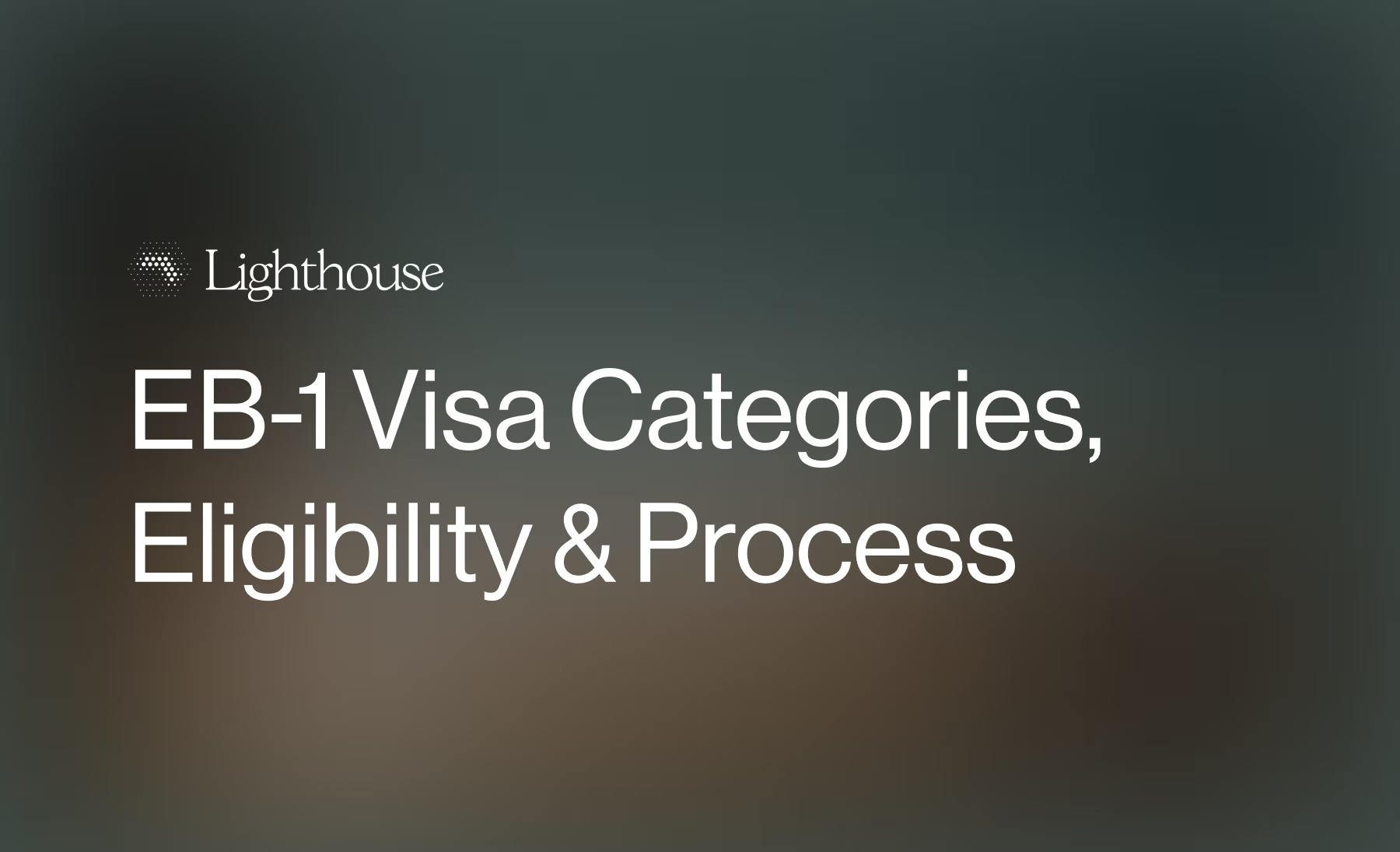The EB-2 Visa Explained
Your complete guide to the EB-2 green card for skilled professionals.


If you're a skilled professional with an advanced degree or exceptional ability in your field, the EB-2 visa offers a direct path to U.S. permanent residency. This employment-based immigrant visa category is designed for individuals whose expertise can contribute to the American economy and workforce and who are ready to begin their U.S. immigration journey through a visa application that leads to a green card.
What Is the EB-2 Visa?
The EB‑2 visa is a second‑preference, employment‑based immigrant visa that leads to a green card and lawful permanent resident status.
“Second‑preference” refers to the EB‑2 category’s place within the U.S. employment‑based immigration system. Employment‑based (EB) green cards are divided into five preference levels under the Immigration and Nationality Act (INA), from EB‑1 (priority workers) to EB‑5 (investors). EB‑2 is reserved for professionals with advanced degrees or exceptional ability whose skills are in demand in the United States. This ranking determines how visa numbers are allocated each fiscal year and sets your priority date—your place in line for a green card once the petition is approved.
Unlike temporary work visas, EB‑2 status grants permanent residence. It’s meant for skilled professionals who want to build careers and lives in the United States, not just work here temporarily.
This visa category is valuable because it covers a broad range of occupations—from engineers with master’s degrees to researchers with exceptional ability in their fields. For many professionals, it is one of the most direct routes to permanent residence through employment.
The EB‑2 program includes three qualifying paths: the advanced degree, exceptional ability, and National Interest Waiver (NIW) subcategories. You can qualify based on higher education, exceptional professional record, or self‑petition under the NIW if your work benefits the nation enough to waive the job offer and labor certification requirements.
Each year, a limited number of employment‑based second‑preference visas are issued, with no single country receiving more than seven percent of the total. This quota system can create waiting periods, especially for applicants from high‑demand countries such as India and China.
EB‑2 vs. Other Employment‑Based Pathways
Key Evaluation Criteria
USCIS evaluates EB‑2 eligibility using criteria outlined in 8 CFR §204.5(k) and policy guidance from the USCIS Policy Manual. The process involves several key factors that determine both eligibility and strategy.
Educational qualifications: Your degree level and field of study form the foundation of most EB-2 applications. An advanced degree typically means a master's degree or higher from an accredited institution. However, USCIS also accepts a bachelor's degree plus five years of progressive work experience as equivalent to an advanced degree.
Professional achievements: For exceptional ability cases, USCIS looks for evidence that your expertise significantly exceeds what's ordinarily encountered in your field. This might include internationally recognized awards, high salary, published material about your work, or membership in professional associations that require outstanding achievements.
Employer sponsorship vs. self-petition: Most EB-2 applications require a U.S. employer to sponsor your petition and complete the labor certification process. The National Interest Waiver pathway allows you to self-petition without employer sponsorship, but requires demonstrating that waiving the labor certification requirement would benefit the United States.
Labor market conditions: When employer sponsorship is required, your employer must prove through the PERM (Program Electronic Review Management) process that no qualified U.S. workers are available for your position. This involves advertising the job, reviewing applications, and documenting the recruitment process.
EB-2 subcategories comparison
The EB‑2 visa covers three distinct subcategories: advanced degree professionals, individuals with exceptional ability, and applicants eligible for a National Interest Waiver (NIW). Each pathway has its own requirements, documentation standards, and sponsorship rules, but all lead to the same outcome—permanent resident status in the United States.
Advanced degree: This category applies to individuals whose positions require a master’s degree or higher, or a bachelor’s degree plus at least five years of progressive post‑baccalaureate work experience. A U.S. employer must sponsor the petition and complete the PERM labor certification process. Evidence includes official transcripts, degree evaluations for foreign credentials, and letters from prior employers confirming progressive responsibility and experience.
Exceptional ability: This category is designed for professionals whose expertise in the sciences, arts, or business is significantly above what is ordinarily seen in the field. Most applicants are sponsored by a U.S. employer through the PERM process, unless they also qualify for a National Interest Waiver. USCIS requires at least three forms of documentary evidence such as an academic record, professional license, proof of high salary, membership in selective professional associations, or recognition from peers for significant contributions.
National Interest Waiver (NIW): The NIW category allows qualified advanced degree professionals and individuals of exceptional ability to self‑petition, bypassing both the job offer and labor certification requirements. To qualify, you must show that your work has substantial merit and national importance, that you are well‑positioned to advance the proposed endeavor, and that granting the waiver would benefit the United States overall. Supporting evidence typically includes proof of published research, national or international impact, and a record of professional achievements relevant to U.S. interests.
Eligibility Criteria
Advanced degree category
To qualify under the advanced degree category, you must demonstrate educational credentials that go beyond a bachelor's degree. USCIS accepts several pathways to meet this requirement.
Master's degree or higher: The most straightforward qualification is a master's degree, doctoral degree, or professional degree (such as J.D., M.D., or equivalent) from an accredited institution. If your degree is from a foreign university, you may need a credential evaluation to establish U.S. equivalency.
Bachelor's degree plus five years: If you have a bachelor's degree, you can qualify by showing five years of progressive work experience in your professional field. This work experience must be post-baccalaureate and show increasing levels of responsibility. Your employer will need to provide detailed letters documenting your roles, responsibilities, and career progression.
Consider an engineer with a master's in electrical engineering and six years of progressive experience. She would clearly qualify under the advanced degree category, with her employer able to demonstrate both the educational requirement and substantial professional background.
Job requirements: The position you're being sponsored for must require an advanced degree as a minimum qualification. Your employer's job description, recruitment efforts, and business necessity documentation must all support this requirement.
Exceptional ability category
The exceptional ability category requires proving expertise that significantly exceeds what's ordinarily encountered in sciences, arts, or business. USCIS has established six specific criteria, and you must meet at least three.
Official academic record: Documentation showing you have a degree, diploma, certificate, or similar award from a college, university, school, or institution of learning relating to your area of exceptional ability.
Professional experience: Letters from current or former employers showing at least 10 years of full-time experience in your profession.
Professional license or certification: A license to practice your profession or certification for your profession or occupation.
High salary or remuneration: Evidence that you have commanded a salary or remuneration for services that demonstrates exceptional ability. This typically means compensation significantly above the prevailing wage for your occupation and geographic area.
Professional associations: Membership in professional associations related to your field of exceptional ability, particularly those that require outstanding achievements for membership.
Recognition from peers: Recognition for your achievements and significant contributions to your industry or field by your peers, government entities, or professional or business organizations.
National Interest Waiver criteria
The NIW pathway allows self-petition for individuals whose work would benefit the United States to such a degree that the labor certification requirement should be waived. This requires meeting a three-pronged test established by the precedent case Matter of Dhanasar.
Substantial merit and national importance: Your proposed work must have both substantial merit and national importance. This can include work in business, entrepreneurship, science, technology, culture, health, or education that will benefit the United States.
Well-positioned to advance the work: You must be well-positioned to advance your proposed work. This involves showing your education, skills, knowledge, record of success, and plan for future work demonstrate your ability to carry out your proposal.
Beneficial to waive requirements: On balance, it would be beneficial to the United States to waive the labor certification requirements. This typically involves showing that your work is of such national importance that requiring labor certification would hinder rather than serve U.S. interests.
A researcher developing renewable energy technologies might self-petition under NIW by demonstrating that her work addresses climate change (national importance), that her Ph.D. and published research show she's well-positioned to advance the work, and that requiring labor certification would delay important environmental research.
Application Process
The EB-2 visa application process involves multiple stages through the U.S. immigration system, including labor certification (if required), filing Form I‑140 with USCIS, and completing either adjustment of status or consular processing to obtain your green card.
PERM labor certification (if required)
For most EB-2 applications involving employer sponsorship, the process begins with PERM labor certification through the Department of Labor. This step verifies that hiring you won't adversely affect U.S. workers' wages or working conditions. For complete procedural instructions, see the Department of Labor’s PERM program page.
Pre-filing recruitment: Your employer must conduct extensive recruitment efforts, including placing job advertisements in newspapers, professional journals, and job websites. They must also post the position internally and may need to attend job fairs or use recruitment firms, depending on your occupation.
Prevailing wage determination: Your employer obtains a prevailing wage determination from the Department of Labor or uses other acceptable wage sources. The offered wage must meet or exceed this prevailing wage.
Form 9089 filing: After completing recruitment and waiting periods, your employer files Form 9089 with the Department of Labor. This form documents the recruitment process, describes the job requirements, and explains why available U.S. workers were not qualified.
Review and certification: The Department of Labor reviews the application and issues either a certification or denial. Processing times vary but typically range from several months to over a year, depending on the complexity and any audits or requests for additional information.
Form I-140 petition
Once PERM certification is approved (or if filing NIW), your employer files Form I-140 ("Immigrant Petition for Alien Worker") with USCIS. NIW applicants can file this form themselves as self-petitioners.
Petition preparation: The I-140 petition includes the approved PERM certification (if applicable), detailed documentation of your qualifications, evidence that your employer can pay the offered wage, and supporting materials demonstrating you meet the EB-2 criteria.
Filing and review: USCIS reviews the petition to ensure you're qualified for the position and that your employer has demonstrated the ability to pay the offered wage. Premium processing is available for an additional fee, which guarantees a decision within 15 calendar days.
Approval and priority date: If approved, you receive a priority date (usually the date your PERM application was filed, or your I-140 filing date for NIW cases). This priority date determines when you can apply for your green card based on visa availability.
Adjustment of status or consular processing
After I-140 approval, you must wait for a visa number to become available based on the monthly Visa Bulletin published by the Department of State. Once your priority date is current, you can apply for permanent residence.
Form I-485 (adjustment of status): If you're physically present in the United States in lawful status, you can file Form I-485 to adjust status to permanent resident. This process includes a medical examination, biometrics appointment, and potentially an interview.
Consular processing: If you're outside the United States or prefer consular processing, your case transfers to the National Visa Center and then to a U.S. embassy or consulate in your home country. You'll complete Form DS-260, attend a medical examination, and participate in an interview before receiving your immigrant visa.
Processing Times and Visa Bulletin
Understanding timing is crucial for EB-2 planning, as several factors affect how long the process takes from start to green card.
PERM processing: Processing times vary significantly based on case complexity and Department of Labor workload. Check current processing times on the USCIS Processing Times page for the most up-to-date information.
I-140 processing: Standard processing times vary by USCIS service center. Premium processing reduces this to 15 calendar days for an additional fee. NIW cases often process more efficiently since they don't require PERM certification.
Priority date movement: The most variable factor is how quickly your priority date becomes current for final green card processing. This depends heavily on your country of birth and overall demand in the EB-2 category.
Country-specific considerations: Applicants from India and China typically face longer waits due to per-country limitations. Indian EB-2 applicants may wait several years, while Chinese applicants usually have shorter but still significant delays. Most other countries have little to no backlog.
Important note: Processing times and fees change regularly. Always check current USCIS processing times and fee schedules before filing any applications.
Costs and Filing Fees
EB-2 applications involve multiple fees paid at different stages, with some costs borne by employers and others by beneficiaries.
Mandatory filing fees
PERM labor certification: No government fee, but employers typically incur significant costs for required recruitment advertising, prevailing wage determinations, and legal preparation.
Form I-140: $715 filing fee, paid by the petitioner (employer for sponsored cases, beneficiary for NIW self-petitions). Premium processing adds an additional fee but guarantees 15-day processing.
Adjustment of status (Form I-485): $1,440 for the main applicant, plus additional fees for family members. This includes the biometrics fee.
Consular processing: $345 immigrant visa fee per person, plus medical examination fees that vary by country and provider.
Additional expenses
Legal representation: Most applicants work with immigration attorneys, with costs varying significantly based on case complexity and geographic location.
Document preparation: Credential evaluations for foreign degrees, certified translations, and obtaining required civil documents can cost several hundred to over $1,000.
Medical examinations: Required for adjustment of status and consular processing, with costs varying by location and provider.
Important note: Employers must pay certain mandatory fees and cannot pass them to employees. Check current USCIS fee schedules as amounts change periodically.
Your Family: Dependent Visas
Your spouse and unmarried children under 21 can accompany you through the EB-2 process as derivative beneficiaries, meaning they don't need separate petitions.
Who qualifies
Spouse: Your legally married spouse can receive derivative status. Same-sex marriages legally performed in jurisdictions where such marriages are legal are recognized for immigration purposes.
Unmarried children: Your unmarried children under age 21 at the time of filing qualify as derivatives. The Child Status Protection Act helps preserve eligibility for children who age out during processing in certain circumstances.
Family members excluded: Parents, siblings, married children, and children over 21 cannot receive derivative status through your EB-2 petition. They would need separate immigration petitions.
Rights and opportunities
Permanent residence: Derivative beneficiaries receive the same lawful permanent resident status as the principal applicant, with no restrictions on their green cards.
Work authorization: Derivative spouses and children can work immediately upon receiving their green cards, with no employer sponsorship requirements.
Education: Children can attend school at any level, including colleges and universities, often qualifying for in-state tuition after establishing residence.
Path to citizenship: Derivative beneficiaries can apply for U.S. citizenship after meeting the same residency and other requirements as the principal applicant.
Why EB-2 Is a Strong Pathway in 2025
Several factors make the EB-2 visa category particularly attractive for skilled professionals considering permanent immigration to the United States.
Broad professional coverage: The EB-2 category accommodates a wide range of professions, from traditional fields like engineering and medicine to emerging areas like data science and renewable energy. This flexibility means opportunities for professionals across many industries.
NIW pathway availability: The National Interest Waiver option provides a self-petition route for entrepreneurs, researchers, and professionals whose work addresses national priorities. This pathway eliminates the need for employer sponsorship and labor certification.
Family inclusion: The ability to include spouses and children in the same petition provides security for families, avoiding the complex coordination required with other visa types.
Direct permanent residence path: The EB-2 leads to permanent residence once priority dates become current, providing stability and long-term planning opportunities.
Established legal framework: The EB-2 category operates under well-established regulations and precedents, making the process more predictable than newer or frequently changing visa categories.
Choosing the right partner
The EB‑2 visa process involves complex legal requirements, extensive documentation, and strategic decisions that can affect both timelines and compliance. For companies hiring or sponsoring foreign talent, partnering with experienced immigration professionals helps ensure every case is accurate, efficient, and aligned with Department of Labor and USCIS standards.
Lighthouse works directly with employers and company representatives to manage EB‑2 sponsorships and green card processes on behalf of their international employees. Our platform combines technology with legal expertise to handle every stage—from initial eligibility assessments and document preparation through Form I‑140 filing and green card receipt. This allows People, HR, and Legal teams to stay compliant while providing a better experience for their sponsored employees.
If your company is looking to support employees through the EB‑2 process or evaluate candidates for permanent residency sponsorship, have your company get in touch with Lighthouse. We provide transparent pricing, clear timelines, and responsive case management that help teams stay in control of their immigration programs.
Frequently Asked Questions
Can I self-sponsor for an EB-2 visa?
Yes, through the National Interest Waiver (NIW) subcategory. You must demonstrate that your work has substantial merit and national importance, you're well-positioned to advance your proposed endeavor, and waiving the job offer requirement benefits the United States. This option particularly suits researchers, entrepreneurs, and professionals whose work serves broader U.S. interests beyond a single employer.
What's the difference between EB-2 and EB-2 NIW?
Standard EB-2 requires employer sponsorship and labor certification (PERM), proving no qualified U.S. workers are available for your position. EB-2 NIW allows you to self-petition without employer sponsorship or labor certification by demonstrating your work benefits U.S. national interests. NIW typically processes faster since it skips the PERM stage, saving 6-8 months on average.
How long does the entire EB-2 process take?
Timeline varies significantly based on your pathway and country of birth. Standard EB-2 with PERM takes 12-18 months through I-140 approval. Add 8-14 months for adjustment of status if visa numbers are current. Indian and Chinese nationals face additional waiting periods for visa availability, sometimes several years. EB-2 NIW eliminates PERM processing time.
What evidence proves exceptional ability?
You need to meet at least three regulatory criteria: degree or certificate in your field, 10+ years of full-time experience, professional license, high salary for your services, professional association membership, or recognition from peers and organizations. Quality matters more than quantity. Strong evidence clearly demonstrates your expertise significantly exceeds what's normally found in your field.
Can my employer pay the fees?
Your employer must pay PERM costs and the I-140 filing fee by law. They cannot pass these expenses to you. Premium processing fees can be paid by either party. For adjustment of status (I-485) fees, either you or your employer can pay. Many employers cover all immigration-related costs as part of their retention strategy.
What happens if I change jobs during the process?
During PERM or before I-140 approval, changing employers means starting over with the new employer. After I-140 approval, you retain your priority date even if changing employers, though the new employer must file a new I-140. Once your I-485 has been pending for 180 days, you can change to a same or similar occupation without affecting your green card application under AC21 portability rules.
Do I need to maintain status while waiting?
Yes, you must maintain lawful status throughout the process unless you're adjusting status and have pending I-485 with work authorization. Many EB-2 applicants continue on H-1B, L-1, O-1, or other temporary visas while awaiting permanent residence. If you're abroad during consular processing, status maintenance requirements don't apply until you enter the U.S. as a permanent resident.
Can I include my adult children?
Only unmarried children under 21 qualify as derivatives on your EB-2 petition. Children who turn 21 during processing may "age out" and need separate petitions. The Child Status Protection Act provides some protection for children who age out due to processing delays. Married children or those over 21 require separate family-based or employment-based petitions.
Lighthouse provides expert guidance and legal review to strengthen your case.

%201.svg)


